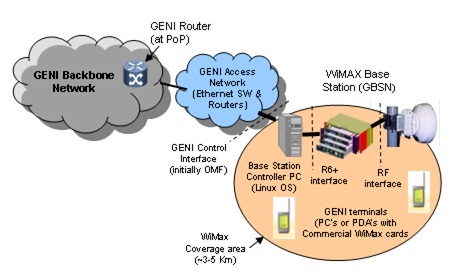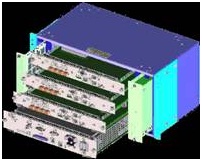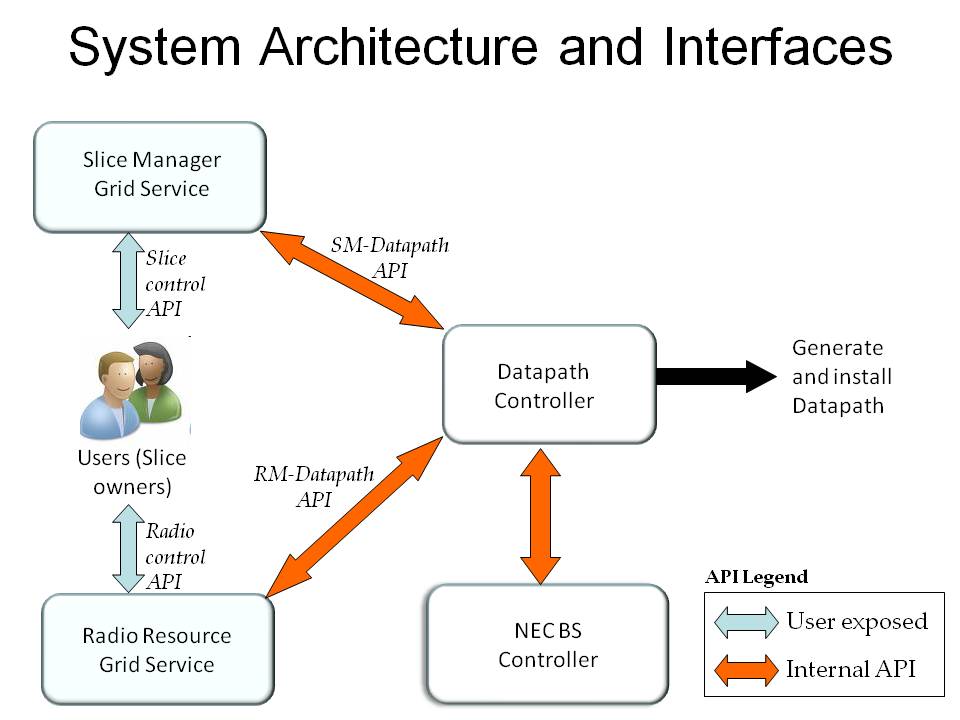| Version 11 (modified by , 16 years ago) ( diff ) |
|---|
WiMAX
This is a GENI project that addresses the challenges of integration and trial deployment of a commercial Mobile WiMAX radio as part of an open virtualized experimental framework. The project leverages a commercial 802.16e base station from NEC, replacing the standard WiMAX controller with an open software implementation that supports virtualization and layer 2/3 programmability. The most prominent features provided by the modifed BS control framework include the capability to perform all frame switching using purely layer 2 information, and control mechanisms to provide isolation across slices, which is needed to ensure experiment repeatability.
Integration of the WiMAX Basestation with GENI
 The figure above shows a schematic representation of the WiMAX base station router and its connection to the rest of the network. As shown, the WiMAX base station is typically connected to a GENI access network with layer 2 switched connectivity using Ethernet or optical fiber technology. The figure also indicates three distinct interfaces associated with the GENI WiMAX base station. The first is the GENI control interface for experimenter access to virtual networks (slices) supported by the external base station controller. This is the primary interface relevant to a GENI experimenter, and is currently based on the ORBIT Management Framework (OMF). The second interface is the so-called R6+ interface by which the base station controller communicates with the base station hardware (which includes its own internal controller running a proprietary NEC operating system and control/management software). The R6+ interface exposes the hardware features such as assignment of MAC/PHY resources (i.e. OFDMA time-frequency slots, power levels, service classification, etc.) to each flow, as well as management interfaces for initial configuration, scheduler policy selection and queue management.
The figure above shows a schematic representation of the WiMAX base station router and its connection to the rest of the network. As shown, the WiMAX base station is typically connected to a GENI access network with layer 2 switched connectivity using Ethernet or optical fiber technology. The figure also indicates three distinct interfaces associated with the GENI WiMAX base station. The first is the GENI control interface for experimenter access to virtual networks (slices) supported by the external base station controller. This is the primary interface relevant to a GENI experimenter, and is currently based on the ORBIT Management Framework (OMF). The second interface is the so-called R6+ interface by which the base station controller communicates with the base station hardware (which includes its own internal controller running a proprietary NEC operating system and control/management software). The R6+ interface exposes the hardware features such as assignment of MAC/PHY resources (i.e. OFDMA time-frequency slots, power levels, service classification, etc.) to each flow, as well as management interfaces for initial configuration, scheduler policy selection and queue management.
Hardware
Software
The virtualized WiMAX Basestation Transceiver (BTS) system consists of different sets of APIs shared by components of the system. A brief overview of the interaction between different system components is as shown in the Figure 1. The slice manager (SM) service allows the user to perform basic setup functions such as slice creation, instantiation, and destruction. The Radio management (RM) grid service allows the user to invoke all the WiMAX radio functionalities when operating as part of a slice. The SM and RM services in turn talk to other system components such as the datapath controller and NEC BS controller to execute API invoked by the Slice owners. The Datapath controller module is responsible for laying out the L2 datapath from the slice virtual machines to the physical WiMAX BTS. The NEC BTS controller allows for the getting and setting of various WiMAX radio features.
Attachments (3)
-
SysArch.jpg
(62.0 KB
) - added by 16 years ago.
System Architecture and Interfaces
- GENI_WiMAX_Overview.jpg (38.5 KB ) - added by 16 years ago.
-
WimaxHw.jpg
(16.1 KB
) - added by 16 years ago.
NEC WiMAX Base Station
Download all attachments as: .zip


